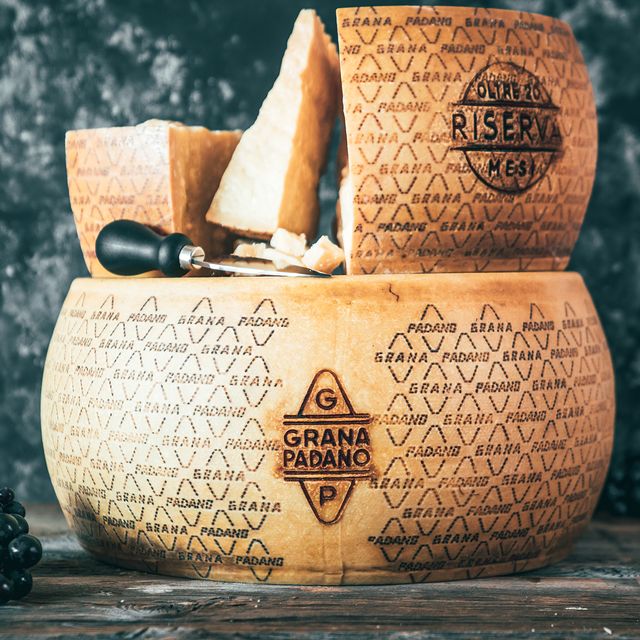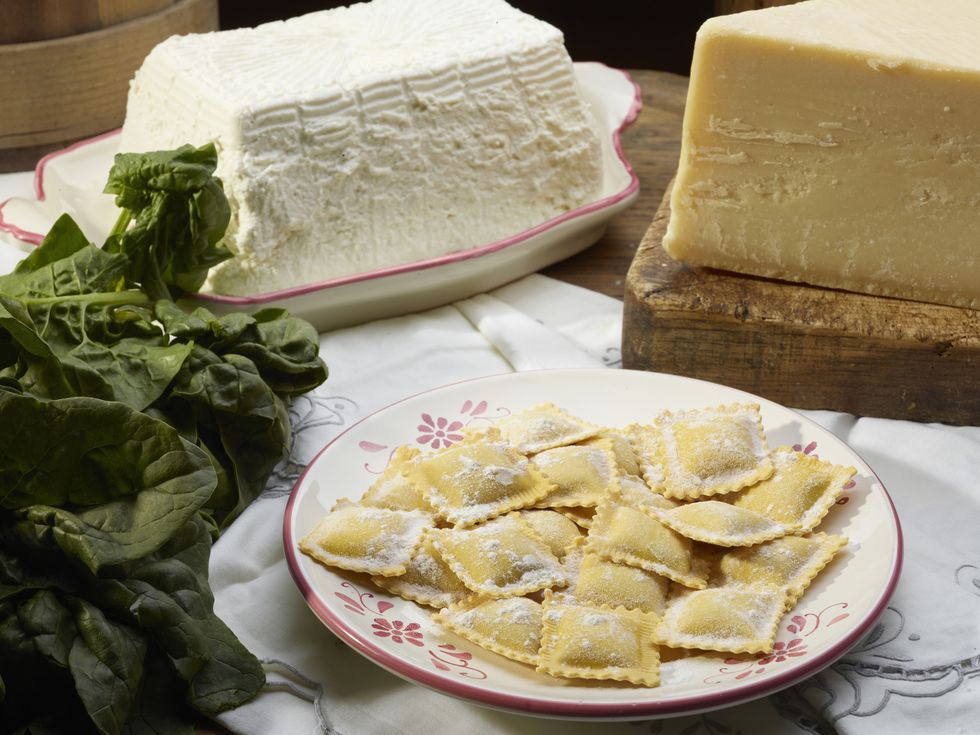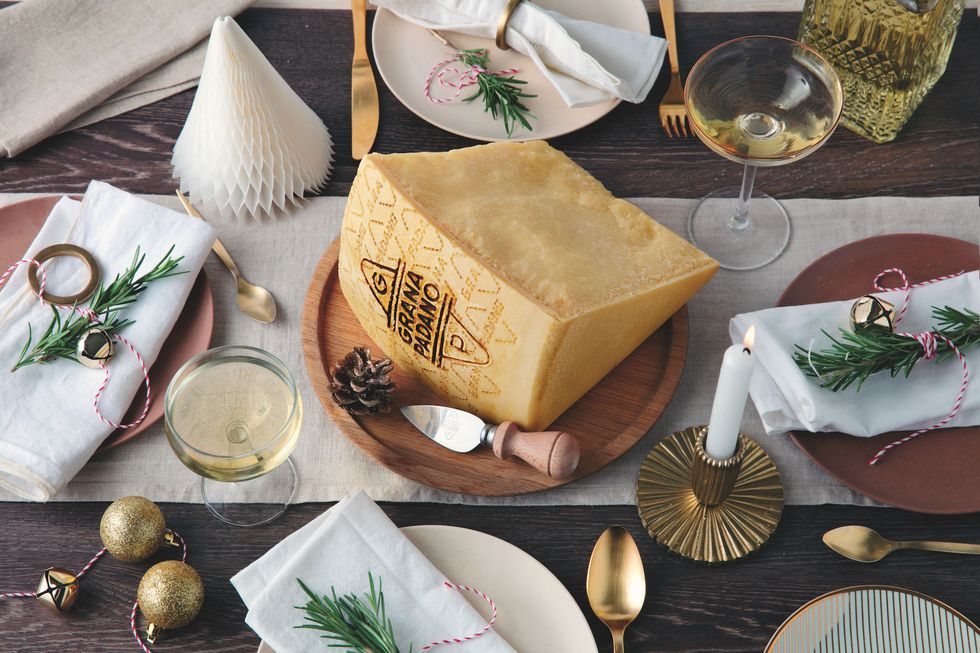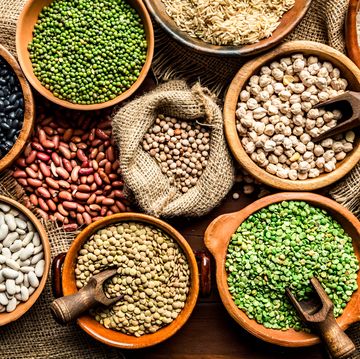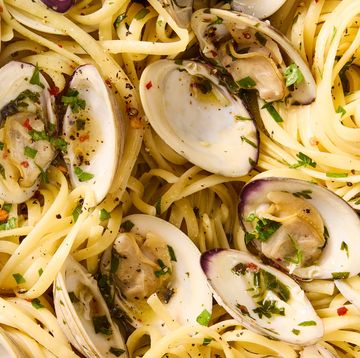If you’re anything like us, you’re constantly looking for excuses to work cheese into your diet. For inspiration, we’re taking after our turophile (that's the fancy term for "cheese-lover") friends in Italy—and turning to one of the country's best-selling varieties. Grana Padano is known for its hard, crumbly texture and savory, nutty bite (chef’s kiss)—similar to that of its cousin, Parmigiano-Reggiano, but with a slightly sweeter effect. Italians have been incorporating it into recipes for almost a thousand years, since it was first created by Benedictine monks looking to make use of a milk surplus. Their invention lives on today as an aged cheese crafted from partially-skimmed, raw Italian milk found exclusively in northern Italy’s Po River Valley.
The secret behind Grana Padano is its aging process. Each wheel spends nine months maturing, before having to pass strict quality control tests administered by the Grana Padano Protection Consortium. Only after acing these assessments will the cheese get the literal seal of approval: it’s fire-branded with the marking that allows it to officially be deemed Grana Padano. (If you spot “Riserva” on the label, that batch has undergone an additional 11 months of aging, further intensifying the cheese’s depth of flavor). The extensive maturation process, coupled with specific production methods (such as preparation in a copper cauldron and at least two weeks spent marinating in brine), results in a lactose-free cheese (prego, lactose-intolerants!). Use Grana Padano as you would any grateable cheese, anywhere you could use an extra punch of umami, or simpluy enjoy a chunk on its own. Here are some ways to incorporate it into your next meal con gusto.
Grate it
Grating your Grana Padano might sound obvious, but the trick is to match the grade to the intensity of the dish. For example, try a delicate snow-like dusting over a lighter dish such as a raw shaved Brussels sprout salad. You can accomplish this using a microplane and a gentle hand. Or, go big and bring out your heavy-duty grater to wield thick curls for a garnish that packs a punch—an approach that's suited to heartier pastas or risottos.
Rind it out
Before you toss out the rind of a Grana Padano wedge, consider saving it to add to a stock or soup. This edible section of the cheese infuses your broth with savory, nutty notes that add depth (and help you resist the urge to load up your dish with salt). Just don’t forget to clean the rind (use a gentle brush) before adding it to the pot and remove it before serving—or cut it into small pieces before dropping it in the pot to avoid biting into a large, chewy chunk. Pro tip: Try cutting the clean rind into small squares, then placing the squares between two sheets of parchment paper and microwaving until you hear them pop (about 30 seconds). Ecco! You'll have mouthwatering, crispy nuggets that you can snack on like popcorn, or sprinkle onto salads as you would croutons.
Whip it (whip it good)
Incorporate Grana Padano into ricotta, mozzarella or any other spreadable cheese to enrich an otherwise mild variety. This combo can be used to add zip to lasagnas, stuffed shells, or ravioli centers. Generally, the milder, spreadable cheese will make up the bulk of the filling, so whisk in roughly one part grated Grana Padano to every three parts of the complementary cheese.
Fold it
Nope, folding cheese does not mean attempting to crease it down the middle before dropping it in your concoction. In short, the art of folding involves gently stirring a sauce in an upward motion in order to mix in a cheese without breaking the sauce. The melted goodness that results from this technique is dynamite in richer, creamier dishes like cacio e pepe, alfredo, carbonara, risotto, and of course, mac and cheese. What’s more, you can shake off some of your cheese guilt: Grana Padano (reminder: lactose-free Grana Padano!) is packed with vitamins, minerals and nine amino acids that make it a worthwhile indulgence.
Sweeten it
To finish: cheese for dessert! And we’re not talking cheese plates, although Grana Padano would be the star of any charcuterie board. This cheese makes a delightful counterpart to fruity or nutty desserts: think stone fruits, orchard fruits, or dried fruits (oh my). Work a dash of Grana Padano into fruity filling, then pipe the salty-sweet confection into cookies or donuts for an unexpected twist; or grate the cheese into pancake batter or pie shells to liven up your baked staples.

